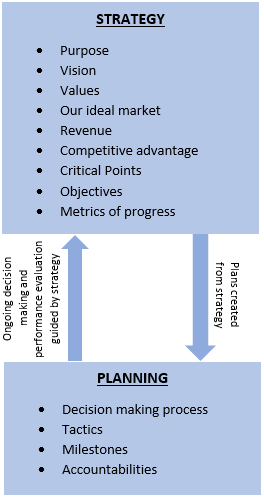Aborting Strategy Work for the Ease of Tactical Execution
Posted on February 06, 2020
Planning is relatively easy. Come up with a bunch of tactics, assign them to people for execution, keep them accountable for results and progress is hopefully being made.
However, in the absence of a strategic direction, tactical execution is similar to heading out on a road trip with no set destination in mind. We might see a lot of countryside, meet a lot of people and enjoy the gratification of knowing we have driven many miles but we never actually arrive. We make plans up en-route but given there is no destination in mind, the roads we take and the places we stay are more spontaneous choices along with way—good ideas at the time. This might work for a "let's see what happens, driving holiday" but running an effective and profitable organisation in an ever-changing world without an established strategic direction can be extremely ineffective in the long run.

Strategy Work is Destination Work.
Strategy is a thoughtful, top-down process where we define who we are (and who we aren't) along with where it is we are headed. It doesn't involve tactics. For planning and tactics to be effective, they must be formed in relation to, and aligned with, our strategic direction. If they do not represent this "strategic relationship", they result in a collection of well-meaning but isolated tasks on the road to nowhere. Strategy work involves looking at some of the following areas:- What is our Purpose?
- What is our Vision?
- Our Values. What will we stand by?
- What are our ideal Markets and where are they based (location)?
- Where will our Revenue come from?
- Competitive Advantage. What makes us unique and distinct?
- Critical Points. Critical issues needing to be addressed.
- Critical Objectives to achieve our vision.
- Metrics of Progress.
The Strategy - Planning Relationship
Below I have sought to represent the relationship between Strategy and Planning to demonstrate how they are linked.
Aborting Strategy with Tactics
Given that strategy is thoughtful and deliberate work, we sometimes opt for getting immediate runs on the board via tactical planning and execution. "We can't think about this forever so let's just do something" is the abortion tool. Tactics identified and implemented too early in the strategic identification process aborts strategic clarity and direction. If the strategy is birthed, it is likely to be ill-formed from a shortened incubation period. The strategic process doesn't need to be a long process but it does need to:- be deliberate and focused;
- incorporate "what if" scenarios;
- involve big picture thinking;
- be exploratory in nature;
- have everything questioned;
- be given time to settle and then reviewed;
- be documented;
- be embedded in our organisation's culture.
Dust Covered Strategy
I've often come across business strategies and plans in beautiful binders but covered in layers of dust. They were formulated and documented sometime in the past but never seen the light of day for many years. The strategic document should be a living, breathing piece of work that is constantly reviewed, changed if required and used for all ongoing decision making. "Does what we are planning now, relate to our strategic direction?" is the question that should always be asked when considering tactical planning and execution in any area. This keeps our organisations on track to the pre-established destination. If markets change, new opportunities emerge or disruption is occurring in our industry, the strategy can be reworked where and as required with new plans implemented for its fulfilment.Summary
Strategy work is thoughtful work and involves thinking and collective senior leadership processing. It is courageous work because it places us in a short-term zone where we feel we are not doing anything. (From all my work with organisations over the years, thinking and planning time is most often ascribed to as waste). Our penchant is for activity which provides more immediate gratification and the sense of movement, despite the fact that the movement might be in the totally wrong direction. And it is worthwhile work, driving us into the future with a destination by which we can evaluate everything against. Most are good at tactical execution but aligning these actions against a clearly defined strategic direction provides a powerful driving force into the future.View latest blog articles
